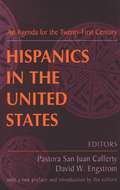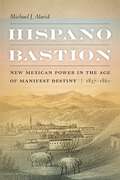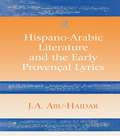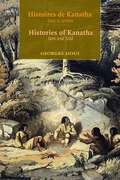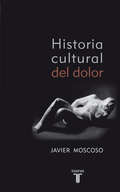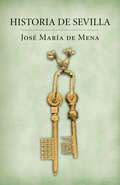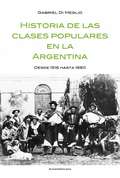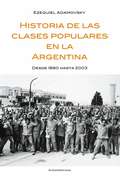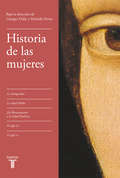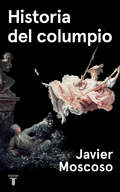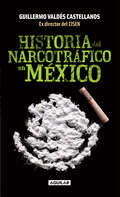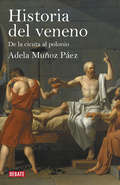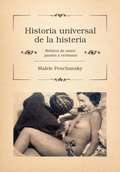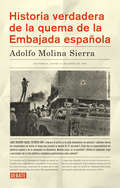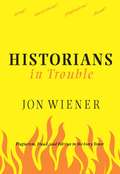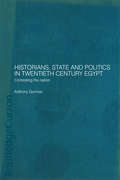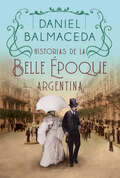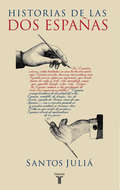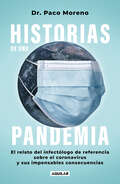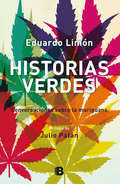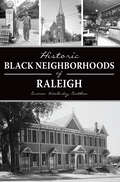- Table View
- List View
Hispanics in the United States: An Agenda for the Twenty-first Century
by Pastora San Juan CaffertyHispanics in the United States represents a collective exploration providing a basic foundation of the information available to understand Hispanics in the United States and create an effective policy agenda. Hispanics are projected to be the largest minority group in the United States in the twenty-first century. The contributions define an agenda which will be useful for students, scholars, service practitioners, political activists, as well as policy makers. The opening essays define the diversity of the Hispanic experience in America and put each of the other essays within a larger context. This edition adds a new introduction by the editors incorporating and evaluating the implications of the results of the national 2000 census. The book is organized into two sections: the first establishes the historical, demographic, religious, and cultural context of Hispanics in the United States. The second describes the major issues facing this population in the American social structure, specifically the areas of health care, the labor market, criminal justice, social welfare, and education. The work concludes with a discussion of the role played by Hispanics in the political life of the nation. The contributors, all of whom are scholars with demonstrated competence in the areas, include: Teresa A. Sullivan, David Maldonado, Melissa Roderick, Barry Chiswick, Michael Hurst, Zulema Suarez, Alvin Korte, Katie McDonough, Cruz Reynoso, and Christine Marie Sierra, as well as David Engstrom and Pastora San Juan Cafferty. Together they have produced a book which will be extremely useful to anyone developing public policies and creating social interventions at either the national or local levels during the coming decade. This new edition is a valuable contributor to discussions about the issues defining the population that will be the largest minority group in the United States in this century.
Hispano Bastion: New Mexican Power in the Age of Manifest Destiny, 1837-1860
by Michael J. AlaridIn this groundbreaking study, historian Michael J. Alarid examines New Mexico&’s transition from Spanish to Mexican to US control during the nineteenth century and illuminates how emerging class differences played a crucial role in the regime change. After Mexico won independence from Spain in 1821, trade between Mexico and the United States attracted wealthy Hispanos into a new market economy and increased trade along El Camino Real, turning it into a burgeoning exchange route. As landowning Hispanos benefited from the Santa Fe trade, traditional relationships between wealthy and poor Nuevomexicanos—whom Alarid calls patrónes and vecinos—started to shift. Far from being displaced by US colonialism, wealthy Nuevomexicanos often worked in concert with new American officials after US troops marched into New Mexico in 1846, and in the process, Alarid argues, the patrónes abandoned their customary obligations to vecinos, who were now evolving into a working class. Ultimately wealthy Nuevomexicanos, the book argues, succeeded in preserving New Mexico as a Hispano bastion, but they did so at the expense of poor vecinos.
Hispano-Arabic Literature and the Early Provencal Lyrics
by J. A. Abu-HaidarAs the distinctive contribution of Islamic Spain to Arabic literature, the strophic muwashshahand zajal are still viewed by some as a development from putative Romance prototypes. No less than seven theories of origin of the Provençal lyrics have been proffered, foremost among them being the Arabic origins theory. This book lets the strophic muwashshah tell its own tale of a natural development in the context of classical Arabic literature.
Histoires de Kanatha - Histories of Kanatha: Vues et contées - Seen and Told
by Georges SiouiCette collection est le premier ouvrage par un autochtone canadien qui discute le concept d’histoire des peuples autochtones et l’expérience coloniale. Tout au long de ces textes, écrits dans plusieurs genres pendant vingt ans, Georges Sioui reprend les idées des Hurons-Wyandots au sujet de la place des Autochtones au Canada, dans l’histoire et le monde. -- This is the first collection written by an Aboriginal Canadian on the Aboriginal understanding of history and the colonial experience. These essays, stories, lectures, and poems, written over the last twenty years by Georges Sioui, present and explore the perspectives of the Huron-Wyandot people on the place of Aboriginal people in Canada, in the world, and in history.
Historia cultural del dolor
by Javier MoscosoUn original estudio de uno de los fenómenos culturales más universales y desconocidos. El dolor, que la mayor parte de las veces carece de justificación, posee sin embargo una historia. Los gestos de las vírgenes mártires, las burlas que acompañaron las desventuras de don Quijote, las penitencias que tuvieron lugar, a escondidas, en el interior de los conventos, las pequeñas comedias del masoquismo sexual, el teatro anatómico del Mundo Moderno, las muecas de los pacientes anestesiados, los dolores conscientes del trastorno nervioso o los inconscientes de la enfermedad mental, se dan cita en este libro. Al contrario de lo que afirmaba el filósofo Cioran, para quien era imposible dialogar con el dolor físico, todas y cada una de estas páginas abogan por ese encuentro y potencian ese diálogo. A medio camino entre la historia y la filosofía, este ensayo versa sobre las formas sucesivas (que no progresivas) de materialización de la experiencia del daño, sobre las modalidades artísticas, jurídicas o científicas que han permitido, desde el Renacimiento hasta nuestros días, la comprensión cultural del sufrimiento humano. La representación, la simpatía, la imitación, pero también la coherencia, la confianza o la narratividad son algunos de los recursos retóricos y argumentativos que los hombres y las mujeres hemos ido utilizando, y todavía usamos, para sentir nuestro dolor, pero también para expresarlo y dotarlo de significado y valor colectivo.
Historia de Nosotros, el pueblo Los documentos fundacionales (Social Studies: Informational Text)
by Torrey MaloofHistoria de Sevilla
by José María MenaUna edición actualizada y ampliada de Historia de Sevilla, ilustrada con nuevas fotografías y material inédito aportado por el autor. José María de Mena, el más célebre historiador de Sevilla, recorre en esta obra la historia de esta gran ciudad andaluza, remontándose a los esplendorosos y enigmáticos tiempos de los tartesios. Mena nos ilustra sobre la fundación fenicia de Sevilla y su conversión en Hispalis, capital bética de la Hispania romana. Sevilla destacó durante la época visigoda por la figura de san Hermenegildo, considerado el rey de Andalucía, y en la Edad Media acogió al célebre arzobispo san Isidoro. Tras la derrota en tierras andaluzas de don Rodrigo, la ciudad se adentró en el período musulmán, durante el cual Sevilla no perdió ni un ápice de su importancia histórica. De hecho, la corte de Motamid, el rey poeta de Sevilla, brilló por ser la más suntuosa de la época y por contar con la presencia de los artistas y rapsodas más destacados del mundo islámico. La Reconquista cristiana y el descubrimiento de América devolvieron a la ciudad el protagonismo que le correspondía. La Exposición Iberoamericana de 1929, la Exposición Universal de 1992, la celebración del V Centenario del descubrimiento del continente americano... Sin lugar a dudas, la historia de Sevilla atesora un acervo cultural, político y económico de gran calado, a la altura de las más grandes ciudades europeas.
Historia de la inmigración en la Argentina
by Fernando DevotoEste libro examina la experiencia migratoria de millones de personas que arribaron a la Argentina a lo largo de 250 años. El autor analiza el movimiento migratorio europeo hacia América desde distintas perspectivas y explora el proceso de inserción de los inmigrantes en la sociedad argentina desde los tiempos coloniales hasta el presente. Son indagados aquí las ideas y las políticas de los grupos dirigentes, los mecanismos de incorporación de los inmigrantes a la actividad económica y la vida de las distintas comunidades. En el apéndice se estudia al vasto e incesante flujo de los inmigrantes que provienen de países limítrofes.
Historia de las clases populares en la Argentina: Desde 1516 hasta 1880
by Gabriel Di MeglioEste libro cuenta la historia de las clases populares en lo que hoy esla Argentina, desde el inicio de la invasión española en 1516 hasta elsurgimiento del país «moderno» hacia 1880. Es la historia de la gente común, la que formaba la base de la pirámidesocial, de quienes no tienen calles que lleven sus nombres: losindígenas que fueron sometidos y los que resistieron la conquista; losesclavos y los morenos libres; los mestizos, pardos y blancos pobres;los campesinos, peones y arrieros; los gauchos, los artesanos y la plebede las ciudades. Este trabajo sintetiza la obra de muchos historiadores,narra historias colectivas e historias individuales. Se ocupa de la vidalaboral y cotidiana de hombres y mujeres del mundo popular; de suparticipación política y militar; de la costumbre, la religiosidad y losconflictos sociales; de las resistencias, las rebeliones, las montonerasy el federalismo. La historia de nuestro país no se entiende si no secomprende la historia de sus clases populares.Esta obra tiene una segunda parte, que abarca el período desde 1880hasta 2003.
Historia de las clases populares en la Argentina: Desde 1880 hasta 2003
by Ezequiel AdamovskyLa Argentina es incomprensible sin tomar en cuenta el desempeño que hantenido las clases populares. Este libro cuenta la evolución del paísdesde los tiempos de la organización nacional hasta 2003. La mirada está puesta en los diversos aspectos del mundo popular, desdela vida cotidiana, la cultura, la religiosidad y el trabajo hasta lasidentidades, las ideologías, las formas de organización gremial y deacción política. No se trata solo de una historia de los trabajadores,sino de la totalidad múltiple de los grupos que componen las clasespopulares en todo el territorio. Peones, obreros y empleados, campesinosy pequeños productores de cada región; inmigrantes europeos, perotambién de países vecinos; criollos, afroargentinos, indígenas, tantovarones como mujeres, son los protagonistas de esta historia. Se dacuenta aquí del aporte que su presencia significó en la formación de laArgentina como país y se indaga, al mismo tiempo, sobre su lugar en elescenario actual, ofreciendo al lector una síntesis de las mejoresinvestigaciones académicas de los últimos años.Esta obra tiene una primera parte, que abarca el período desde el iniciode la invasión española en 1516 hasta el surgimiento del país «moderno»hacia 1880.
Historia de las mujeres (edición estuche): La Antigüedad | La Edad Media | Del Renacimiento a la Edad Moderna | El siglo XIX | El siglo XX
by Georges Duby Michele PerrotLos cinco tomos de la obra pionera que supo responder a la necesidad de darles a las mujeres un espacio propio en la Historia, por los prestigiosos historiadores Georges Duby y Michelle Perrot, en una magnífica edición estuche. La AntigüedadLa Edad MediaDel Renacimiento a la Edad ModernaEl siglo XIXEl siglo XX Esta Historia de las mujeres responde a la necesidad de ceder la palabra a las mujeres. Alejadas, desde la Antigüedad, del escenario donde se enfrentan a los dueños del destino, reconstruir su historia significa describir su lento acceso a los medios de expresión y su conversión en persona que asume un papel protagonista. Este análisis implica, asimismo, que las relaciones entre los sexos condicionan los acontecimientos, o la evolución de las sociedades. No se buscan conclusiones tajantes sino que las mujeres encuentren, al fin, su espacio propio. Esta obra busca analizar cómo las relaciones de los sexos condicionan la evolución de las sociedades y la necesidad de que las mujeres encuentren, al fin, su espacio propio.
Historia del columpio
by Javier MoscosoLa fascinante historia, alejada del parque infantil, de un artilugio empapado de magia, pasiones, leyendas, ritos, goce, erotismo, diversión o muerte. El columpio ha acompañado a los seres humanos desde la Grecia clásica o la China preimperial. Sus usos han labrado un terreno fecundo entre el arte y la vida, entre el ritual y el conocimiento, entre la cultura y el juego. Javier Moscoso, uno de los ensayistas españoles más originales y prestigiosos, indaga en el placer de la oscilación y en la universalidad de este instrumento, principalmente femenino, a través de sus usos, significados y metáforas, con ecos y maravillosas coincidencias en épocas y lugares remotos: de la escoba de la bruja al yoga aéreo, de la horca a la esta galante. Moscoso explora con brillantez la presencia y el papel del columpio en las obras de Watteau, Fragonard o Goya, entre otros muchos; el movimiento pendular como juego de transposición en el que la mujer adopta la posición dominante; o las asombrosas zonas de confluencia con otras tradiciones culturales, en la India, Corea, Tailandia o China. Relacionado desde la Antigüedad con el sexo y con la muerte, empleado por dioses y por locos, instrumento erótico y terapéutico al mismo tiempo, el columpio es un objeto imprescindible, aunque olvidado, en la historia universal de la experiencia humana.
Historia del narcotráfico en México
by Guillermo Valdés CastellanosUn análisis implacable y excelentemente documentado sobre los orígenes y alcances del narcotráfico en México, escrito por una de las voces más autorizadas en temas de crimen organizado, narcotráfico y política mexicana. El problema del narcotráfico en México ha alcanzado niveles insospechados debido a los acuerdos siniestros entre los líderes de los cárteles y los cuerpos policiacos, por la complicidad con algunos miembros del gobierno y las negociaciones establecidas por los narcos con militares y cuerpos de seguridad.El alto posicionamiento de los narcotraficantes resulta impactante y digno de un análisis cuidadoso. Guillermo Valdés lo ofrece en estas páginas de manera puntual y objetiva; elabora un recuento de sus protagonistas y los mecanismos que emplearon para alcanzar la cima en el negocio de los estupefacientes. Habla de grupos que ganan terreno cada día por medio del crimen, el asesinato y el comercio voraz, así comolas prácticas utilizadas para fortalecer sus bandos e imponer su ley.Guillermo Valdés, titular del Centro de Investigación y Seguridad Nacional (CISEN) durante el gobierno de Felipe Calderón, en una de las etapas más críticas del enfrentamiento entre el Estado y los narcotraficantes, elabora una radiografía insuperable de este fenómeno social que fractura el orden social de nuestro país. Basado en un trabajo de campo agitadísimo, caracterizado por una delicada toma de decisiones, así como en años de investigación sobre problemas sociales de México, seguridad nacional y ejercicio del poder, el autor analiza las primeras expresiones del narcotráfico en nuestro país durante las décadas de los años veinte a los cuarenta del siglo pasado, el auge y la consolidación monopólica de 1940 a 1980, las fragmentaciones y rupturas durante los últimos años del siglo XX y la guerra franca del gobierno mexicano contra el narco en el presente siglo.Meticuloso y revelador, Guillermo Valdésdetalla las acciones de los narcotraficantes y sus alcances en cuanto a ganancias, territorio y formas de operar; repasa el origen del comercio de drogas y las estrategias de sus actores esenciales: desde Caro Quintero, Ernesto Fonseca: #Don Neto# y Félix Gallardo, hasta #El Mayo# Zambada, los Beltrán Leyva, Amado Carrillo: #El señor de los Cielos#, Joaquín #El Chapo# Guzmán, los Arellano Félix y Héctor #El Güero# Palma, entre muchos otros personajes que, en complicidad con comandantes de la policía, agentes ministeriales, representantes del ejército y políticos, han conformado un grupo de poder sin precedentes.Historia del narcotráfico en México es, sin duda, la investigación más importante sobre la guerra contra el narco y sus protagonistas, además, un documento esclarecedor, objetivo y sincero, escrito desde lo más profundo de la problemática y con necesidad de contar la verdad, aunque sea dolorosa.
Historia del veneno
by Adela Muñoz PáezLa fascinación del ser humano por los venenos se remonta al principio de los tiempos. Ya en el antiguo Egipto y en el mundo grecorromano, los tósigos se convirtieron en un arma de poder. En Roma fueron muchos los emperadores que alcanzaron la gloria gracias a ellos: Nerón mató a su madre, Agripina la Menor, quien a su vez había asesinado al emperador Claudio para conseguir la corona de su hijo. También en la Italia renacentista, y en la Francia de Luis XIV, las pócimas causaron estragos, y reyes, cortesanos y plebeyos perdieron la vida bajo sus efectos.Cicuta, arsénico, cianuro, talio, polonio? Adela Muñoz realiza un insólito recorrido por los momentos más relevantes de la historia a partir de envenenamientos célebres, y nos descubre la composición de los venenos que acabaron con la vida de personajes ilustres como Sócrates, Cleopatra, el emperador Claudio, Rasputin o Adolf Hitler. Una fascinante historia desde la cicuta de la Antigüedad al polonio de nuestros días.
Historia en meme: (el libro)
by Guillermo Pérez RomeroLa historia universal contada de manera fácil y divertida, ¡y con memes! ¿En la Prehistoria solo la mujer recolectaba? ¿Las pirámides de Egipto las construyeron únicamente los esclavos? ¿Cómo realmente fue la Conquista de América? ¿Qué tuvo de especial la censura cinematográfica con Franco? ¿Cómo fue la noche de bodas de Carlos III? ¿De dónde viene la tradición de «poner el Belén»? ¿Cuál es el origen histórico de las expresiones «poner los cuernos» o «acabar con el rosario de la Aurora»?
Historia universal de la histeria: Relatos de amor, pasión y erotismo
by Malele PenchanskyDesde la histérica paradigmática Anna O. hasta la observación de rasgoshistéricos en personajes de nuestros días, Malele Penchansky logra unfresco audaz y provocativo sobre un síntoma que, sostiene, no esprivativo de las mujeres ni tan malo como nos hicieron creer. Después detodo, de la histeria se nutre el juego amoroso. La histeria femenina fue diagnosticada por la medicina occidentalantigua como una enfermedad que provenía de perturbaciones del útero ycuyo tratamiento era conocido como "masaje pélvico", que consistía en laestimulación de la zona de los genitales hasta llegar al orgasmo. Elmismo Freud se interesó especialmente por la histeria y más cerca denuestro tiempo la psicoanalista francesa Diane Chauvelot la caracterizócomo un síntoma social. El origen de la histeria fue cambiando y losigue haciendo.«Historia universal de la histeria» recrea algunas historias atravesadaspor este síntoma: la mirada de la Medusa, la palabra que enamora enSócrates y Alcibíades, el travestismo y la ambigüedad en Juana de Arco,o la seducción masculina del Don Juan.
Historia verdadera de la quema de la Embajada española
by Gustavo Adolfo Molina SierraLo sucedido en la Embajada de España no puede ser tomado como una coincidencia o casualidad. Por el contrario, todo se integra como parte de un plan, eso sí, mal ejecutado, que al salirse de control falló aparatosamente y causó una tragedia. Aun así se trató de sacar provecho de esta desgracia. Estos intentos mantuvieron el caso activo, pero no existió la voluntad política para investigarlo judicialmente hasta el 2014. Guatemala, jueves 31 de enero de 1980. ¿Qué sucedió en aquel fatídico día? ¿Ingresó la policía a la sede diplomática sin permiso? ¿Quienes fueron los responsables de iniciar el fuego que provocó la muerte de 37 personas? ¿Cuál fue la responsalibidad del gobierno español y de su embajador en Guatemala, Máximo Cajal, en lo sucedido? ¿Utilizó el embajador Cajal a personas de la vida política y académica guatemalteca como señuelo? ________________________________________________________________ A lo largo de 40 años, desde aquella lejana fecha del jueves 31 de enero de 1980, Adolfo Sierra Molina ha recopilado cuanta información se ha publicado relacionada con la ocupación y quema de la Embajada de España. Se convirtió también en una de las voces que desde el inicio expuso, a través de numerosos artículos y dando su testimonio una y otra vez, la versión de hechos de los que él fue testigo y que ha ido completando con las pruebas de personas que estuvieron presentes. Su padre, Adolfo Molina Orantes, un destacado abogado, académico, humanista y exfuncionario, murió tragicamente junto a otras 36 personas, entre las que se encontraban Eduardo Cáceres Lehnhoff, funcionarios españoles, personal guatemalteco, así como los que tomaron la sede diplomática desde las primeras horas de la mañana. Uno de los invasores fue encontrado con vida por los bomberos cuando ingresaron al despacho del embajador Máximo Cajal López, quien, minutos antes, había salido caminando de la habitación en la que se habían atrincherado. Adolfo Molina Sierra revela y analiza lo sucedido poniendo los puntos sobre las ies y señalando sin tapujos a los responsables en una historia que no es solo suya, sino también de Guatemala.
Historians in Trouble
by Jon WienerHistorians in Trouble is investigative journalist and historian Jon Wiener's "incisive and entertaining" (New Statesman, UK) account of several of the most notorious history scandals of the last few years.Focusing on a dozen key controversies ranging across the political spectrum and representing a wide array of charges, Wiener seeks to understand why some cases make the headlines and end careers, while others do not. He looks at the well publicized cases of Michael Bellesiles, the historian of gun culture accused of research fraud; accused plagiarists and "celebrity historians" Stephen Ambrose and Doris Kearns Goodwin; Pulitzer Prize-winner Joseph J. Ellis, who lied in his classroom at Mount Holyoke about having fought in Vietnam; and the allegations of misconduct by Harvard's Stephan Thernstrom and Emory's Elizabeth Fox-Genovese, who nevertheless were appointed by George W. Bush to the National Council on the Humanities.As the Bancroft Prize-winning historian Linda Gordon wrote in Dissent, Wiener's "very readable book . . . reveal[s] not only scholarly misdeeds but also recent increases in threats to free debate and intellectual integrity."
Historians, State and Politics in Twentieth Century Egypt: Contesting the Nation (Routledge Islamic Studies Series)
by Anthony GormanThis book deals with the relationship between historical scholarship and politics in twentieth century Egypt. It examines the changing roles of the academic historian, the university system, the state and non-academic scholarship and the tension between them in contesting the modern history of Egypt. In a detailed discussion of the literature, the study analyzes the political nature of competing interpretations and uses the examples of Copts and resident foreigners to demonstrate the dissonant challenges to the national discourse that testify to its limitations, deficiencies and silences.
Historias de la Belle Époque argentina
by Daniel BalmacedaUna invitación a recorrer los espléndidos años dorados de la Belle Époque argentina. De las últimas décadas del siglo XIX al Centenario de la Revolución de Mayo, en 1910, y los años previos a la Primera Guerra Mundial. Este libro es una invitación a recorrer los espléndidos años dorados de la Belle Époque argentina. De las últimas décadas del siglo XIX al Centenario de la Revolución de Mayo, en 1910, y los años previos a la Primera Guerra Mundial. Una época de gran prosperidad, cuando el porvenir era esperanza y desarrollo. Tiempos de inmigración masiva; de inicio del ocio, de la gastronomía, del transporte y de mujeres que, por primera vez, se animaban a reclamar sus derechos. Espiamos el diario de Delfina Bunge y sus observaciones de quienes iban a misa, asistimos a un baile de fin de año, presenciamos el primer llamado telefónico, la aparición de los autos eléctricos, el miedo frente al primer vuelo en avión y el caso cero de una temible vuelta de la fiebre amarilla. ¿Cómo eran los dandis por esos días? ¿Cuántos años tenía el niño que quiso matar a Roca? ¿Cómo desbarató José Hernández una edición trucha del Martín Fierro? Decenas de casos de emprendedores que armaron un imperio con una máquina rudimentaria en un sótano: de Fort a Rigolleau. Historias nacidas de la incansable búsqueda que Daniel Balmaceda realiza desde hace años en periódicos, revistas y documentos inéditos de todo tipo, para descubrir y rearmar las piezas perdidas de nuestra historia.
Historias de las dos Españas
by Santos JuliáUna historia coral de las sucesivas, contradictorias y enfrentadas historias de las dos Españas. «Dos Españas, señores, están trabadas en una lucha incesante», dijo en cierta ocasión Ortega, resumiendo con su proverbial aplomo una historia de siglos. Dos Españas que son, más que el resultado de un análisis, el gran relato de un pasado con el propósito de abrir un futuro: «una España muerta, hueca y carcomida y una España nueva, afanosa, aspirante, que tiende hacia la vida». De esa creación cultural y de los sujetos que la inventaron y la echaron a rodar trata este magistral libro de Santos Juliá, en un recorrido que abarca desde los primeros escritores públicos, testigos de la revolución liberal de principios del siglo XIX, a los jóvenes intelectuales de mediados del siglo XX, protagonistas de la recusación del gran relato de las dos Españas. Entre medias, la generación del 98, que dio a España por muerta; los catalanes, que despertaron a su nación para incrustarla en una Espanya gran; las gentes del 14, que hablaron de una España viva; los jóvenes de la República, que acabaron llorando su pérdida; los católicos, que salieron a su reconquista; y los fascistas, que la soñaron, unida e imperial, a orillas del Arlanzón. ** Obra galardonada con el Premio Nacional de Historia de España 2005.
Historias de muerte y corrupción: Calderón, Mouriño, Zambada, El Chapo, La reina del Pacífico
by Julio Scherer García"Sin medir la magnitud del problema que enfrentaba, Calderón se metió entero en el agua helada de un océano sin orillas. Ignoró o no fue consciente de que el narco se había infiltrado en las capas altas, medias y bajas de la sociedad a lo largo de cincuenta años de priísmo complaciente y durante el periodo del foxismo cómplice." Julio Scherer García Las historias que escribe Julio Scherer García en este libro responden a la brutalidad del México de nuestros días. "El narco está en la sociedad, arraigado como la corrupción", explicó el Mayo Zambada en la entrevista que el autor le hizo en marzo de 2010. En estas páginas, donde se revelan los entretelones y las secuelas de aquel encuentro, Scherer nos relata cómo el crimen organizado ha permeado todos los órdenes de la vida nacional, dejando un país incendiado por la violencia y regido por la descomposición, la impunidad, el encubrimiento y la violación de los derechos humanos. Estas historias de muertey corrupción tienen como protagonistas, además de los narcos, a los gobernantes, los policías, los políticos, los jueces, los soldados, los niños sicarios y los civiles caídos en la guerra "que no lucha" contra la delincuencia organizada. Estos últimos forman parte de las descarnadas estadísticas, enlistados como "daños colaterales" y, según registra fehacientemente el autor, de ellos se responsabiliza el comandante supremo de nuestras Fuerzas Armadas. Así, como primera conclusión, la respuesta a la pregunta que aquí se plantea resulta clave: ¿podría juzgarse al presidente por los inocentes muertos? "Detrás de cada víctima "apunta Scherer" hay un nombre, un apellido, una historia, pero llegará el día del rendimiento de cuentas por parte de quienes se vieron envueltos en esta tragedia que no cesa."
Historias de una pandemia: El relato del infectólogo de referencia sobre el coronavirus y sus impesansables consecuencias
by Paco Moreno"Paco, con su conocimiento y valentía, fue el infectólogo que a muchos nos trajo la luz en la oscuridad de esta pandemia. En este libro describe, con la claridad que lo caracteriza, lo que todos vivimos estos últimos años. Recomiendo su lectura ampliamente." -ARTURO ELIAS AYUR En diciembre de 2019 la noticia de una neumonía desconocida que asolaba a la ciudad china de Wuhan parecía un relato de ciencia ficción. Algunos meses más tarde, las es-cenas apocalípticas de metrópolis desiertas, hospitales desbordados y millones de personas confinadas se repetían por todo el mundo: era el inicio de la pandemia del coronavirus. El doctor e infectólogo Paco Moreno, quien estuvo en la primera línea de batalla contra este virus, fue un testigo privilegiado del avance devastador de la pandemia. Desde su trinchera, Moreno rescata historias de coraje y sobrevivencia, y también de quienesperdieron a sus seres queridos; de aquellos hombres de ciencia que, poniendo su vida en riesgo, no cesaron de buscar una cura; de aquellos errores políticos que se tradujeron en cientos de miles de muertes que pudieron haberse evitado. A la par, sus explicaciones en torno a las vacunas, el sistema inmunológico y el funcionamiento del virus, entre otras, enriquecen estas páginas. Pero fundamentalmente que-dan aquí los testimonios del espíritu humano ante la adversidad y lo desconocido, así como las reflexiones y enseñanzas que la pandemia nos ha dejado y que debemos atender si queremos un mejor futuro.
Historias verdes: Conversaciones sobre la mariguana
by Eduardo Limón¿Fumar o no fumar?, ésa es la cuestión a la que se enfrenta nuestra conciencia el día en que, por primera vez, se presenta ante nosotros la posibilidad de darse un "toque", o, más comúnmente dicho: un churro de mota. Escritores, músicos, científicos, promotores culturales y hasta tres dealers se dan cita en las páginas de Historias verdes para hablar del singular momento en que se encontraron con la mítica planta. Cada uno crea una crónica de su vida a partir de ese episodio; leer estos testimonios resulta pertinente frente al debate de la posible legalización de la mariguana en México. Eduardo Limón, periodista y escritor de gran trayectoria, conduce estas conversaciones y comparte algunas experiencias, y lejos de tomar una postura ante este polémico tema, apuesta por conciliar los gustos, las aversiones, los pros y contras en el consumo de la cannabis. Conversaciones con Fernando Rivera Calderón, Bef, Paco Ignacio Taibo II, Armando Vega-Gil, Joselo, Xavier Velasco, Ana Clavel, Fernanda Melchor, Ruzo, Juan Ramón de la Fuente y tres dealers. ¿Hay algo más humano que drogarse? FERNANDA MELCHOR Mariguana: un tema que dejó de ser prohibido y se volvió controvertido. JUAN RAMÓN DE L A FUENTE
Historic Black Neighborhoods of Raleigh (American Heritage)
by Carmen Wimberley CauthenThe story of Raleigh's African American communities begins before the Civil War.Towns like Oberlin Village were built by free people of color in the antebellum era. During Reconstruction, the creation of thirteen freedmen's villages defined the racial boundaries of Raleigh. These neighborhoods demonstrate the determination and resilience of formerly enslaved North Carolinians. After World War II, new suburbs sprang up, telling tales of the growth and struggles of the Black community under Jim Crow. Many of these communities endure today. Dozens of never before published pictures and maps illustrate this hidden history.Local historian Carmen Wimberly Cauthen tells the story of a people who--despite slavery--wanted to learn, grow, and be treated as any others.
